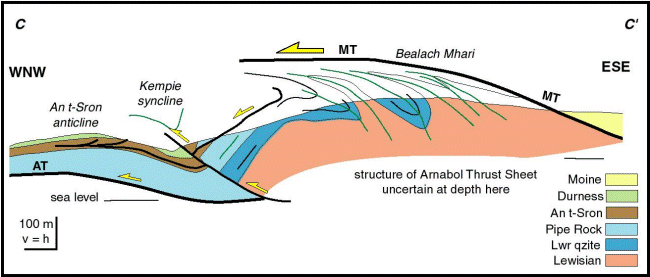Bealach Mhari - Kempie section

The ground above Kempie bay provides an excellent place to examine major folds developed adjacent to the Moine thrust and the ductile reworking of the folds into mwtre-scale alternations of mylonitic rock types. The axis of a major syncline runs south from Kempie Bay and a complementary anticline to the west. This Kempie Syncline has a steep east limb that runs up into a series of folds traced, at the current exposure level, by the basal Cambrian unconformity. At Bealach Mhari the folds are upright to eastward-inclined with a wavelength of several hundred metres in the north. However, to the south towards the structurally higher Moine thrust, the folds become tight to isoclinal, only a few metres in wavelength with axial surfaces sub-parallel to the gently-dipping foliation in the Moine mylonites. The interfolding of Lewisian gneisses and Cambrian quartzites is accompanied by intense deformation. The Lewisian gneisses are recrystallised into fine-grained chloritic phyllonites. The quartzites show intense l-s fabrics with a prominent, ESE-plunging mineral lineation and locally developed shear bands. In thin section the quartzites show abundent evidence for crystalline plasticity with ribbon grains (Evans and White 1984). Petrofabric studies of these rocks (Law et al., 1984) indicate a combination of overthrust shear and layer extension. These observations suggest that some of the folding within the Arnaboll thrust sheet was synchronous with at least the later part of mylonite development. Overall the geometry suggests that this zone acted as a ductile roof thrust with fold axial surfaces replacing the thrusts of the conventional duplex.